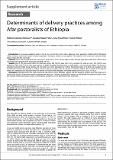| dc.contributor.author | Getachew Mekonnen, Medhanit | |
| dc.contributor.author | Yalew, Kassahun Negash | |
| dc.contributor.author | Umer, Jemal Yesouf | |
| dc.contributor.author | Melese, Muluken | |
| dc.date.accessioned | 2021-08-17T19:37:44Z | |
| dc.date.available | 2021-08-17T19:37:44Z | |
| dc.date.issued | 12/26/2012 | |
| dc.identifier.citation | Medhanit Getachew Mekonnen, Kassahun Negash Yalew, Jemal Yesouf Umer, Muluken Melese. Determinants of delivery practices among Afar pastoralists of Ethiopia. Pan Afr Med J. 2012;13(Supp 1):17 | en_US |
| dc.identifier.issn | 1937-8688 | |
| dc.identifier.uri | http://dspace.amref.org/handle/123456789/72 | |
| dc.description | This article is published as part of the supplement “AMREF´s evidence in advancing the health of women and children”
Supplement sponsored by AMREF - African Medical and Research Foundation
© Medhanit Getachew Mekonnen et al. The Pan African Medical Journal - ISSN 1937-8688. This is an Open Access article distributed under the terms of the Creative
Commons Attribution License (http://creativecommons.org/licenses/by/2.0), which permits unrestricted use, distribution, and reproduction in any medium, provided the
original work is properly cited. | en_US |
| dc.description.abstract | Introduction: In a previous qualitative study in Afar, it was reported that most mothers deliver at home, assisted by Traditional Birth Attendants
(TBAs). However, determinant factors of delivery practices in this region remain scarcely explored. The objective of this study was to elucidate these
factors among the Afar community.
Methods: This cross sectional study was conducted in April 2011 in zone 3 of Afar regional state, Ethiopia. Quantitative data were collected from
478 women who had given birth during the preceding one year.
Results: Out of 478 interviewed mothers in urban/rural areas, 398 (83.3%) gave birth to the youngest child while at home; 370 (92.5%) were
assisted by TBAs. Only 3.2% of them were assisted by Health Extension Workers/nurses in health posts or at home during delivery. We found an
association between health facility delivery and ante-natal care (ANC) attendance (p<0.001), educational status (p<0.001) and occupation of the
husband/wife (mother) and gravidity (p=0.003); but there was no association with the number of wives the husband had (p=0.566). In the adjusted
model, ANC attendance and education status of mother were significantly associated with health facility delivery (p=0.036; p<0.001).
Conclusion: Most deliveries in the study community took place at home. Educated mothers and ANC attending mothers have high tendency for
health facility delivery. Programmes need to strengthen the capacities of mothers to attend ANC services, as well as build the capacity of Health Extension Workers (HEWs) and nurses working in health posts, in order to win the confidence of the community | en_US |
| dc.language.iso | en | en_US |
| dc.publisher | Pan African Medical Journal | en_US |
| dc.subject | Traditional birth attendant | en_US |
| dc.subject | Antenatal care | en_US |
| dc.subject | Educated mother | en_US |
| dc.title | Determinants of Delivery Practices Among Afar Pastoralists of Ethiopia | en_US |
| dc.type | Article, Journal | en_US |

